|
| |
|

|
|
|
| july - september 2004 | focus on film 12 | |
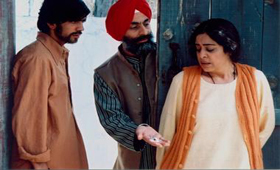
Silent Waters 
Crimson Gold 
Père 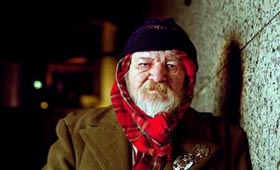
The pharaoh 
Fuse 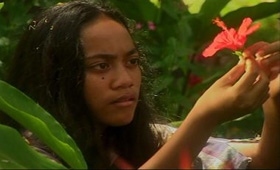
The land has eyes 
Father & Son 
Zatoichi 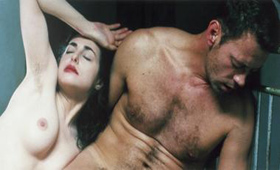
Anatomie de l´enfer 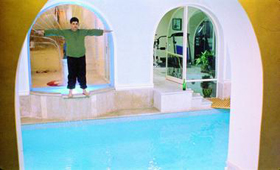
Grimm 
Dutch Light |
| review |
|
||
| 33rd Rotterdam International Film Festival by Adriana Schmorak January 21st through February 1st, 2004. |
|
||
| The Rotterdam International Film Festival was first held in 1972 and is currently one of the most important cultural events in The Netherlands, mainly focusing on independent and experimental films. The Festival is divided into various sections, such as the VPRO Tiger Awards, which are given to first or second movies; the Hubert Bals Foundation, which supports filmmakers from developing countries; the Amnesty International award, which presents movies dealing with human rights and dignity; and a main program featuring long and short films from different parts of the world. This year, during its 10-day run, the Festival hit the same record as last year with 355,000 viewers in attendance at viewing rooms, debates, seminars and conferences. The winners were announced on Friday, January 30th at the De Doelen Theater. In a special ceremony the VPRO Tiger Awards were given to the Taiwanese film "The Missing", by director Lee Kang-Sheng and the Hubert Bals Foundation Awards went to "Summer in the golden Valley", by Sredjan Vuletic and "En Route" by Jan Krüger. The Amnesty International Award went to "The Last Train", by Alexei German from Russia, and "Uniform", from China and directed by Diao Yinan, received a Special Mention. On Saturday January 31st the Festival came to a close with the projection of the British film based on Dutch subject matter: The Girl with a Pearl Earring directed by Peter Webber and recently nominated for an Oscar for best costume design. Bistart attended these events and made a selection of films based on different topics, ranging from the situation of women in the Muslim world, the current relationship between developed countries and their former colonies, to the influence of Dutch paintings in movies. Silent Waters Sabiha Sumar, Pakistan, 2003, 35 mm, 99 minutes The story is set in Charkhi, a small town of the Pakistani Punjab, where a young widow named Aicha, devotes her life to raising and educating her only son Salim and teaching the Koran to a group of girls. "Silent Waters" is based on a true story and constantly links the lives of the characters with the tumultuous history of Pakistan from its creation to our days. This history begins when the Muslim community of India separates in 1947 and founds a new country in the north, succeeded by a string of territorial conflicts and internal confrontations. The movie is narrated by one of the female characters, Zoubida, Salim·s girlfriend, who in turn embodies Sumar·s, director and co-writer, point of view. The silent and eerie waters, to which the title refers, occupy the sad memory of the tormented Aicha and contrast with the bright colors of the wedding ceremony at the beginning of the film. Sabiha Sumar deals with issues such as intolerance, fanaticism and the unenviable life of the women in her native country. In her own words: “Telling stories is important for any cultural life. I hope my work helps to revive movie culture in Pakistan and contributes to the development of alternative films there.” Crimson Gold Jafar Panahi, Iran, 2003, 35 mm, 97 minutes. Jafar Panahi ("The Mirror", 1997; "The Circle", 2000) presents the tragic story of a pizza delivery man, who is sick, humiliated and driven to desperation by a society ruled by a unbreachable gap between the rich and the poor. Panahi, unlike in "The Circle", no longer touches on the subject of the persecution of women, but on the differences between classes in the country, as well as in the rest of the world. A shrill scream is recurrently repeated and its source is never revealed, it probably refers to Hussain·s (the main character) internal state, in representation of most of the Iranian people who live in poverty while observing the opulence they will never have access to. Hussain·s drama not only springs from the situation but also from the awareness of such situation. The narrative is circular, beginning and ending at the same point in time: the mugging. It is presented in long sequential planes to which the director has accustomed us and that Iranian filmmaking has inherited from Italian Neorrealism. Père Naguel M. Belouad, Algeria, 2004, 35 mm, 89 minutes. Le jardin de papa Zeka Leplaine, Congo/France, 2003, 35 mm, 75 minutes These are two examples of current African films that deal with the same subject matter: Europe·s relationship with its former colonies, but from two different perspectives. Père, by Naguel Belouad from Algeria, is the story of Mahmoud, a young man who lives in the north of Africa and decides to travel to Marseilles in search of his father, whom he has never met. From this point, he embarks on an adventure that includes getting a passport with a visa in order to legally enter European territory. Père is the hallucinated vision of a young man obsessed with the idea of realizing a dream, one that becomes more difficult to reach, eventually turning into a chimera. Mahamoud represents the idealized vision of young people living in so-called Third World countries who dream of emigrating to big cities. Thus, the narrative is full of inner visions and voices, surreal and dream-like images in impossible times that never develop chronologically, but take place in temporal scenes, with ellipses that are later completed or with sequences that are repeated from different angles and points of view. Le jardin de papa, by Zeka Leplaine from the Congo, presents the same issues as Père, but from the point of view of its European characters. Jean and Marie are French newlyweds who decide to honeymoon in Africa, where Jean was born and grew up. Things have changed since then and the events that unfold in the story are evidence of the critically tense and unequal relationship between black and white people, between Europe and its former colonies and this creates a conflict in the couple. The title, Le jardin de papa, refers to colonialist Europe that considered the African continent as its own private backyard. These topics were also discussed at a debate held on January 28th at the Rotterdamse Schouwburg, with the title: What African film? Melodrama or authenticity?, with the participation of Nigerian director, Tunde Kelani; South African producer, Jeremy Nathan; and the director of the African Film Festival in London, Keith Shiri. In these discussions, they spoke about independent African films, which gained popularity after the colonialist era in the ·60s, and of the influence of Italian Neorrealism, especially of director Vittorio De Sica and, as expected, of French films. “Going to Europe for money means that Europeans will determine the type of films that are made in Africa. We (Africans) do not have rules such as Dogma 95, but we have rules imposed on us by others” ironically describes Jeremy Nathan, and "We have to free African films from the ghetto it is in now.” The Pharaoh Sinisa Dragin, Rumania, 2004, 35 mm, 82 minutes. Filmed as a documentary, perhaps as a result of its director Sinisa Dragin·s experience as a Reuters cameraman, it is a visual testimony about Rumania in the transition period between the Communist regime and current day. This transition is presented from the perspective of a new generation, represented by the young journalist, on the politically persecuted and exiled generation, embodied by Costache Nicolau nicknamed the Pharaoh, who spent 40 years as a political prisoner in Siberia. Dragin combines sequences in color with others that are in black and white, probably as a reference to a historical past that is never resolved, suspended in air as a way of creating awareness in the young. From this there is a recurring association of images between the majestic Egyptian monuments, such as the Sphinx of Giza, and that old man alienated by the passing of the years and the heavy weight of his past. The director proposes returning to more genuine values, especially to the Christian idea of love as the essential foundation for new generations. Fuse Pjer Zalica, Bosnia-Herzegovina, 2003, 35 mm, 105 minutes. Serbs and Bosnians, after two years of “peace”, far from founding a new and prosperous nation, live in absolute corruption, translated into gambling, prostitution and bribery. All this is evident in a visit by former president of the US, Bill Clinton, to the small town of Tesanj. But as all crises result in change, from this visit Serbs and Bosnians discover that they have more in common than what they thought and there is a possibility of refounding this country, devastated by internal struggles, with a future based on their own cultural values. Zalica shows post-war Bosnia in a tragic-humorous way, with the cleverness of making the audience laugh and reflect at the same time, from a very interesting perspective on the subject. The land has eyes Vilsoni Hereniko, Fiji / U.S.A., 2004, video, 87 minutes. This is the first feature film set and filmed in the Fiji Islands, more precisely on the Island of Rotuma, birth place of director, Vilsoni Hereniko, previously known as author of children·s books and writer and director of plays. The film is set in a time before the independence of Fiji from the United Kingdom in 1970. It is not accidental that the director chose part of a Rotuman proverb for the title: “The land has eyes and teeth and knows the Truth”, since the story is entirely rooted in the myths and legends of this island, in a style equivalent to what in Latin America is called Magical Realism. In The land has eyes the myth is part of reality, it is not simply a tale handed down verbally from generation to generation. The idea is reinforced by the excellent photographic work of Paul Atkins who highlights the bright colors of the exuberant natural surroundings: a blood red twilight and orange fire, a sea that is bluer than the lapis lazuli, pure, intense and bright colors that seem almost unreal and taken from a painting. From Gauguin·s Polynesian women, perhaps? Although the story takes place in colonial times, there are no political issues in that sense. There is more like an idea of syncretism between Christianity, old legends and local customs. The land has eyes has a poetic beauty that is worth mentioning. Bright Future Kurosawa Kiyoshi, Japan, 2003, 35 mm, 92 minutes. Mamoru is a young man with a boring routine. He works at a laundromat, and his attention is mainly focused on his strange pet: poisonous amoebae he takes care of and tries to adapt to fresh water. But, as all living creatures, the amoebae looks for its own place and freedom. The film stands out because it is monochrome, almost completely veering to the color sepia with some shades of blue. Sometimes the grays and whites dominate, in contrast to the amoebae·s own light. These chromatic and lighting resources, as well as the well-thought and bold unorthodox frames, serve director Kiyoshi·s purposes: associating the young people in the film, rebellious and revolutionary, to the amoebas that are in search of freedom in the open waters of the ocean and that can barely adapt to other environments. Kiyoshi·s teenagers have the bright future the title refers to, always moving ahead and fading (effect that is achieved metaphorically and formally in the film) limits with the gray and sepia reality of their surroundings, this sad monochrome world governed by adults. Father and Son Alexander Sokurov, Russia/Germany, 2003, 35 mm, 90 minutes The Return Andrei Zvyagintsev, Russia, 2003, 35 mm, 105 minutes Father and Son and The Return have something in common and a difference. Both are outstanding examples of current Russian filmmaking, both are based on father-child relationships, but while in the former the father·s presence is strong (maybe too strong), the latter focuses on an absent father who returns in search of a home he lost long ago. Known for important movies such as Moloch (1999), Taurus (2001) and The Russian Ark (2002), Alexander Sokurov made this second part of a family trilogy that starts with Mother and Son (1997). A father and his son share an apartment on the last floor of a house and their relationship is symbiotic where no outsiders can interfere, not even the memory of the absent mother. The film is a philosophical reflection about loneliness, angst and the feeling of emptiness brought about by the absence of the Other as well as a fear of Death, translated into the nightmares Alexei relates to his father in the middle of the night. Metaphorically, Sokurov represents death as a lonely and narrow passage that opens in the snow, where the characters walk in absolute solipsism. On the other hand, Andrei Zvyagintsev·s film, winner of the Gold Lion for best picture at the Venice Festival, is the story of two brothers whose lives change drastically when they meet a man who claims to be their father, who they only remember from old photographs. The story is told from Ivan and Andrei·s perspective, and the audience knows as much as they do, which creates a feeling of angst. Who is it about? Who is this man who has been gone for so long and now suddenly returns? Both Father and Son as well as The Return offer a second look that transcends psychological dramas or social opinions. In Sokurov·s movie, the way the father consoles his son when he has nightmares reminds us of the sculpted representations of Pieta, religious image of the Virgin Mary crying over her dead son. So going back to the previous question about Zvyagintsev·s absent father: Could it be God? Has Christ returned to Earth for a second time, as announced in the New Testament? In any case, there is no doubt about how indispensable the vision of these two characters is for impeccable filmmaking. Zatoichi Takeshi Kitano, Japan, 2003, 35 mm, 116 minutes Zatoichi is a blind vagabond who roams the streets of 19th century Japan making a living as a massage therapist, and playing craps with no indication that he possesses great skill and ability in the art of fencing. He is a mythical character that Kan Shimozawa took to literature and that actor, Shintaro Katsu, played in a series of movies made between 1962 and 1973. A new film by Katsu in 1989 and a kind of American remake entitled Blind Fury, directed by Philip Noyce and with Rutger Hauer in the starring role, were added. Zatoichi is part of a very popular genre in Japan, a parallel genre often confused with martial arts films. It is about the “chambara” or fencing movies. One of the most famous cultivators was the mythical Akira Kurosawa and his famous The Seven Samurais (1951), where the focus is not on the fights between noble clans nor on the Japanese civil wars of the 16th century, as in Ran (1986) or Kagemusha (1980), but on the Samurai represented as a defender of justice and of the weak, a hero similar to the ones portrayed in American westerns. At the press conference held by Kitano on Thursday, January 22nd at the De Doelen theater, Kitano himself clarified all these points: the syncretism of genres in his film, his admiration for Akira Kurosawa, among other subjects. Simon Field: “Something you mentioned the other night is the combination of the film which is between chambara and musical.” Takeshi Kitano: “There is also a certain degree of influence of the Kabuki. The pace is crucial in this film, the ending is typical of Japan in the ·50s and ·60s, with people happily dancing and singing. The dance style refers to modern musicals.” In reference to Kurosawa, Kitano talks about the following anecdote: "Kazuko Kurosawa (Akira·s daughter) is costume supervisor for my movie. Once I was sitting and observing a take with rain, and Kazuko was behind me. As a joke I turned around, and said to her: "Rain... fencers... this is a tribute to your father, it is a tribute to the Seven Samurais.” In every joke there is some truth. Kitano·s admiration not only for Kurosawa but also for directors he worked with as an actor is evident. Such is the case with Nagisa Oshima (Taboo, 2000), superb filmmaker obsessed with the subject of homosexuality between Medieval warriors in Japan. Some of which is also portrayed in Zatoichi. Kitan·s distinguishing feature is satire, humor. At moments the audience seems to be watching an American comedy from the period of silent movies, with the characters falling, getting hit on the head and tripping, ending with a tap number by The Stripes group. The result is a very bizarre film with a high degree of eccentricity. Anatomie de l´enfer Catherine Breillat, France, 2004, 35 mm, 77 minutes. Based on the novel by Breillat “Pornocratie”, this film was the star of the Rotterdam Festival. Conferences, talks, photo exhibits, interviews with the director and actors were part of the projection of the movie for the 10 days of the Festival. A man and a woman, the primitive couple, are alone in a room isolated from the world. He is homosexual and she, aware of this, decides to pay him to “study” her female anatomy. Some may consider Anatomie de l`enfer a pornographic or highly erotic film; however, it is based on a profound reflection of the unlikeliness of a real merging of the man-woman relationship due to their diverging natures. The cruelty and anxiety with which the man possesses the woman·s body as an object of desire and, at the same time, the fear of the Other as a different entity are subjects that are present in the entire film. The anatomy of the hell the title refers to is the woman·s anatomy, since from distant times the female sex has been considered the bearer of Evil in the world, the embodiment of all that is demonic. At the press conference held by Catherine Breillat, actress Amira Casar and actor Rocco Siffredi on Friday, January 23rd at De Doelen, some interesting concepts came up about the movie: Breillat: “There is a pictorial element in the film, some features of Italian religious paintings. The female body is like a marble sculpture, it conveys emotion, pays homage to man. There is also some transformation between man and woman, a shift from man to woman to become a Man-Woman hybrid. I·m interested in reproducing colors as symbolic elements. At times I needed purple or blue to capture the female character. My intention is to reproduce the opposition between white and red: Georges de la Tour used strong colors such as green and red.” Amira Casar: “the lighting is solemn and the image is both sacred and profane. The photography was inspired by Man Ray·s nudes and Picasso·s drawings.” The pictorial influences are evident, as Breillat and Casar point out in the conference. The white skin and smooth nudity is reminiscent of Venus of Urbino by Tiziano or of Venus of the Mirror by Velásquez. There is a recurring take of a broken and blackened mirror on the wall reflecting and framing the naked body of the woman lying on the bed. The chiaroscuro effect achieved by Breillat with the use of focused and highly contrasting lighting is reminiscent of the same effect in Caravaggio and in George de la Tour. The furious sea against the diminished image of the man who is looking out towards the horizon is undoubtedly inspired by romantic paintings by Delacroix and C.D. Friedrich. This is not accidental, since the characters in Anatomie de l´enfer are slaves to their passions, of their own Nature, an idea that is present in paintings and literature throughout the romantic movement. The result is a superb film for its formality and conceptuality, but it is one that the general audience finds difficult to accept. Grimm Alex van Warmerdam, Holland, 2003, 35 mm, 94 minutes This film is from the same director as Abel (1986). The title was inspired by homonyms in famous children·s stories like Hansel and Gretel. Jacob and Marie are exactly that, a brother and sister pair, a sort of postmodern Hansel and Gretel, abandoned by their poor parents. Their only hope is to find their uncle·s house in Spain, but what should have been their salvation turns into an absurd adventure full of obstacles, mishaps and struggles, a cross between a children·s story and a Spaghetti Western. A naive look at Grimm makes it a simple updated version of a tale of witches and fairies. However, from the dialogues between the Dutch brother and sister and their sinister Spanish hosts, there is a second reading which refers to a subject which is currently under discussion in Spain: the economic, cultural and social consequences of a European Community that intends to join countries that are very different from each other. Behind the simple facade of a children·s story, Alex van Warmerdam brings up the issue of culture and economic shock and its consequences, which from his point of view, are more dangerous than beneficial for Holland. Thus, it is no surprise that, while at the Rotterdam Festival this film went almost unnoticed, at the San Sebastian Festival it was received with a mix of applause and hisses. Dutch Light Peter-Rim de Kroon and Maarten de Kroon, Holland, 2003, 35 mm, 94 minutes There is an old belief that the light in Holland is unique, but this has never been put to the test. The special quality of the light in Holland was discovered and represented in art. Without it, the works of artists such as Johannes Vermeer, Philips Koninck and Jan van Goyen would not have been the same. In fact, the scientific studies on the nature of the light of Christiaan Huygens and Isaac Newton influenced 17th century Dutch paintings. While Italian paintings were narrative, mythological or religious, in Holland they were almost entirely based on the observation of the landscape and the light. German artist, Joseph Beuys, suggested that Dutch light lost its extraordinary brilliance after an extensive area of the Zuyder Zee in the south of Holland was dried in the mid ·50s. This lead to the demise of a visual culture that started in the 17th century. According to Beuys, the sense of sight was more important to the Dutch, and drying large bodies of water, which reflected the light in a very special way, created a kind of blinding effect. Dutch Light was filmed in a period of 12 months in various parts of Holland, and in the Desert of Arizona, where American artist, James Turrell, has spent the last 30 years studying how to artistically represent light in the crater of a volcano. James Turrell and Jan Andriesse; Dutch artists, Jan Dibbets and Robert Zandvliet: and art historians, Ernst van de Wetering and Svetlana Alpers shared varying points of view on the subject of Dutch light, while scientists, Günter Können and Vincent Icke present scientific evidence both in favor of and against Beuys· hypothesis. “The main difference between Dutch light and the rest, is the water.” (Vincent Icke) “I do not believe that the drying of the Zuyder Zee made any difference. What changed was not the light but the view, we do not see things the same way a person did in the 17th century.” (Jan Dibbets) The Girl with a pearl earring Peter Webber, United Kingdom / Luxembourg, 2003, 35 mm, 95 minutes The story is set in Delft, Holland, in the year 1665. Young Griet enters as a maid in the house of painter, Johannes Vermeer, who is in awe of the beauty of the young woman and decides to paint her portrait, under the jealous eyes of his wife, Catharina. Maria Thies, Vermeer·s mother-in-law, upon seeing that Griet inspires him, decides to allow the relationship so that her son-in-law·s scarce productivity increases. The Girl with a pearl earring is director, Peter Webber·s first feature film. His intention is to tell a version of the story behind the model that inspired Vermeer in the painting with the same name, which is on display in one of the rooms of the Maurits Huis in The Hague. But due to the inaccuracy of historical records, most of the script (based on a novel by Tracy Chevalier) is mostly conjecture. The director has carefully thought out each frame, creating them as paintings by Vermeer in regards to color, lighting, texture and placing the camera from the point of view of an observer of a painting. Also worthy of praise is the representation of the painter in the creative process and performances by the actors. Instead of concentrating on actions and dialogues, gestures and looks speak for themselves. |
|
||
| |
|||
|
magazine
|
gallery
|
guide
|
online projects
|
info
|
newsletter
|
contact us
|